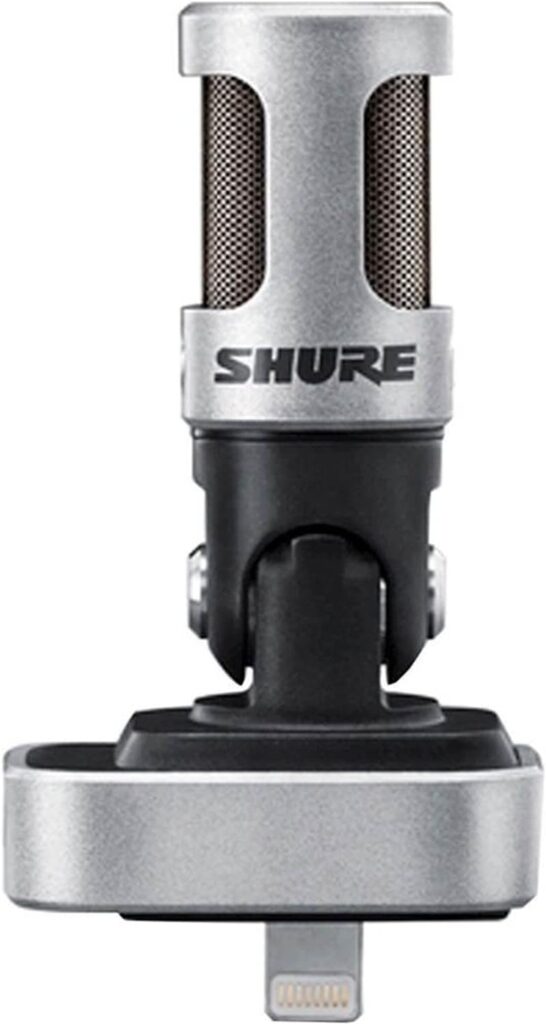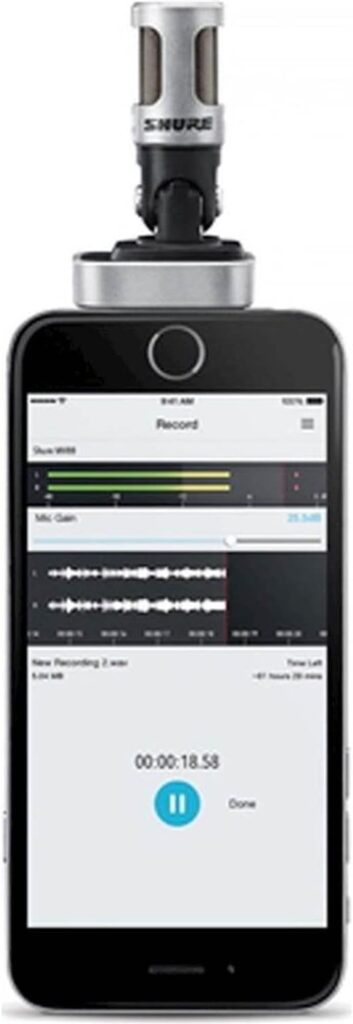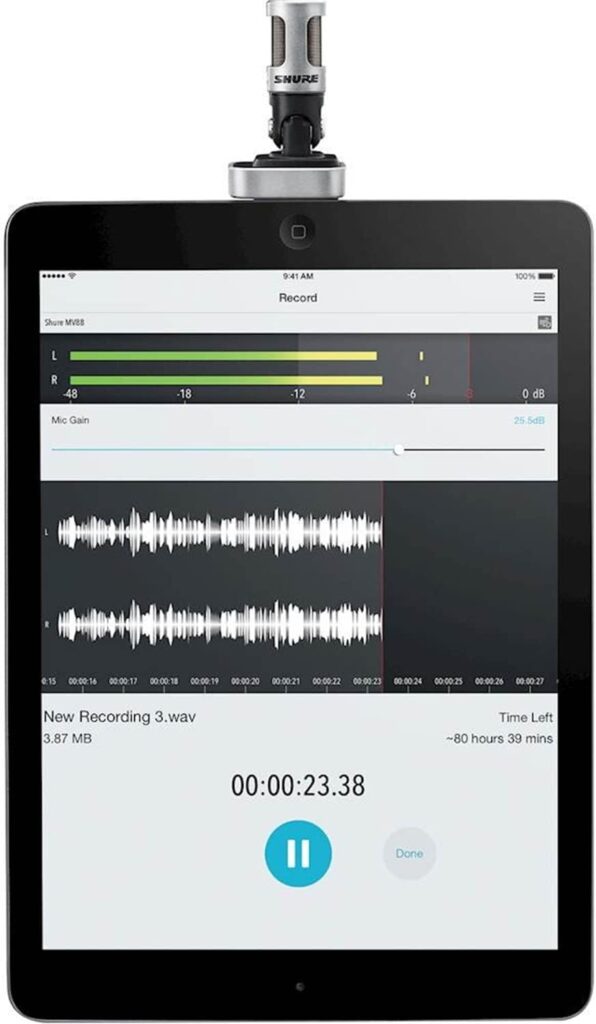Shure MV88 Review
When it comes to capturing high-quality audio on the go, few microphones have garnered as much attention as the Shure MV88. Known for its sleek design, versatility, and impressive sound quality, this compact condenser microphone has become a favorite among content creators, musicians, podcasters, and journalists. Shure, a brand synonymous with professional audio equipment for nearly a century, released the MV88 as part of its MOTIV series, targeting users who need studio-grade recording in a portable package. In this review, we’ll explore the Shure MV88’s design, features, performance, and real-world applications to determine if it lives up to the hype.
Shure MV88 Review
The Shure MV88 is a digital stereo condenser microphone designed primarily for iOS devices, though it’s compatible with other platforms via adapters. Launched in 2015, it was one of the first microphones to combine portability with advanced digital signal processing (DSP), making it a standout in the growing market of mobile recording solutions. At first glance, the MV88 impresses with its compact, all-metal construction and futuristic aesthetic. Weighing just 40.5 grams (1.4 ounces) and measuring roughly 2.5 inches long, it’s small enough to slip into a pocket, yet it feels sturdy and premium.
The microphone connects directly to an iPhone or iPad via a Lightning connector, eliminating the need for cumbersome cables or external power sources. This plug-and-play simplicity is a major selling point for users who value convenience. Shure also includes a foam windscreen, a carrying pouch, and a headphone adapter in the box, ensuring you’re ready to record right out of the gate. For Android users or those with USB-C devices, compatibility is possible with third-party adapters, though the experience may not be as seamless as with iOS.
Design and Build Quality
Shure has a reputation for crafting durable, reliable gear, and the MV88 is no exception. Its housing is made of metal, giving it a robust feel that can withstand the rigors of travel or fieldwork. The microphone’s head pivots 90 degrees, allowing for flexible positioning whether you’re recording a solo podcast, an interview, or ambient soundscapes. This adjustability is a thoughtful touch, especially for a device marketed toward mobile creators who often work in unpredictable environments.
The MV88 features two capsules arranged in a Mid-Side (M-S) stereo configuration, a design choice that enables it to capture sound with remarkable clarity and spatial depth. This setup is typically found in larger, more expensive studio microphones, so seeing it in a portable device is a pleasant surprise. A small grille protects the capsules, and the included windscreen helps reduce plosives and wind noise during outdoor use.
One minor critique of the design is its reliance on the Lightning connector. While this makes it a natural fit for Apple users, it limits out-of-the-box compatibility with non-iOS devices. Additionally, the lack of a built-in stand or clip means you’ll need to hold it, mount it on a tripod, or rely on your device’s positioning, which could be inconvenient in some scenarios.
Features and Functionality
The Shure MV88 isn’t just a microphone—it’s a smart audio solution thanks to its integration with the ShurePlus MOTIV app. Available for free on iOS and Android, this app unlocks the MV88’s full potential, offering a suite of controls that rival standalone audio interfaces. Key features include:
- Five DSP Preset Modes: The app provides five recording modes—Speech, Singing, Flat, Acoustic Instrument, and Loud—each tailored to specific use cases. These presets adjust EQ, compression, and limiting settings automatically, making it easy for beginners to achieve professional results without deep audio engineering knowledge.
- Adjustable Stereo Width: Users can tweak the stereo field from 60 to 135 degrees, allowing for everything from focused mono recordings to wide, immersive stereo captures. This is particularly useful for recording live music or environmental sounds.
- Gain Control: The app lets you adjust input gain up to 36 dB, ensuring you can capture quiet sources or tame loud ones without distortion.
- Real-Time Monitoring: With a headphone jack adapter, you can monitor audio directly through the MV88, a crucial feature for ensuring quality during recording.
- 24-bit/48 kHz Recording: The MV88 supports high-resolution audio, delivering crisp, detailed sound that competes with dedicated studio mics.
Beyond the app, the microphone itself has no physical buttons or controls, relying entirely on software for adjustments. While this keeps the design sleek, it also means you’re dependent on your device and the app to make changes, which could be a drawback if your battery dies mid-session.
Sound Quality
The MV88’s audio performance is where it truly shines. Its dual-capsule design captures sound with exceptional clarity and a natural tonal balance. The frequency response spans 20 Hz to 20 kHz, covering the full range of human hearing, and the microphone handles sound pressure levels up to 120 dB SPL without clipping—a testament to its versatility.
In Speech mode, the MV88 excels at recording podcasts or interviews. Voices sound rich and articulate, with minimal background noise pickup when positioned correctly. The Singing preset adds a touch of warmth and compression, making it suitable for vocalists or singer-songwriters demoing tracks on the go. For instruments like acoustic guitars or pianos, the Acoustic Instrument mode preserves detail and dynamics, while the Loud setting is ideal for capturing amplified performances without distortion.
The Flat mode, which bypasses DSP, is a favorite among purists who prefer to process audio later in software like Logic Pro or Audacity. Here, the MV88 reveals its true character: clean, uncolored sound with a wide stereo image. Outdoor recordings, such as birds chirping or city ambiance, benefit from this mode, though the windscreen is essential to combat breeze interference.
Compared to built-in smartphone mics, the MV88 is a night-and-day improvement. It also holds its own against competitors like the Zoom H1n or Rode VideoMic Me-L, offering superior stereo imaging and app-based flexibility. However, it doesn’t quite match the warmth or depth of larger condenser mics like the Shure SM7B—nor should it, given its size and purpose.
Use Cases and Performance in the Field
The MV88’s portability and versatility make it suitable for a wide range of applications. Podcasters love its ease of use and ability to deliver broadcast-quality audio without a bulky setup. Musicians can record rehearsals, live gigs, or song ideas with minimal gear. Journalists and filmmakers benefit from its directional capabilities and compact form factor, which pairs well with an iPhone for on-the-spot interviews or video shoots.
In a real-world test scenario, imagine recording a street musician playing guitar. With the MV88 plugged into an iPhone and set to Acoustic Instrument mode, the guitar’s strums come through with crisp highs and resonant lows, while the stereo width captures the subtle echoes of the urban environment. Switching to Speech mode for an interview with the musician, the mic isolates their voice effectively, even with traffic noise in the background.
One limitation surfaces in windy conditions: despite the windscreen, strong gusts can still introduce unwanted noise. A third-party “deadcat” windjammer might be a worthwhile accessory for outdoor enthusiasts. Additionally, the lack of onboard storage or standalone recording capability means you’re tethered to your device, unlike some portable recorders that double as mics.
Pros and Cons
Pros:
- Exceptional sound quality for its size
- Intuitive app with powerful customization options
- Durable, portable design
- Wide range of recording modes for different scenarios
- Plug-and-play simplicity with iOS devices
Cons:
- Limited compatibility without adapters for non-iOS devices
- No physical controls on the mic itself
- Wind noise can be an issue outdoors
- Requires a device to function, no standalone recording
Pricing and Value
At its launch, the Shure MV88 retailed for around $149 USD, a price that reflects its premium build and performance. As of March 20, 2025, it’s still available at similar price points, though discounts can occasionally be found through retailers like Amazon or Sweetwater. For comparison, the Rode VideoMic Me-L costs about $79 but lacks stereo recording and app integration, while the Zoom H1n, priced around $119, offers standalone recording but is less portable.
The MV88’s value lies in its balance of quality and convenience. For iOS users seeking a step up from basic mics without investing in a full studio rig, it’s a compelling option. However, if you need broader device compatibility or standalone functionality, you might look elsewhere.
Conclusion
The Shure MV88 is a remarkable piece of audio engineering that punches well above its weight. Its combination of portability, sound quality, and app-driven flexibility makes it a standout choice for mobile creators who prioritize convenience without sacrificing performance. Whether you’re a podcaster, musician, or videographer, the MV88 adapts to your needs with ease, delivering results that rival more expensive setups.
That said, it’s not without flaws. Its iOS-centric design and reliance on a companion device may frustrate some users, and outdoor recording requires extra care to manage wind noise. Still, for its target audience—Apple users who want professional audio in a pocket-sized package—the MV88 remains a top contender nearly a decade after its release.
In a world where content creation is increasingly mobile, the Shure MV88 proves that small doesn’t mean compromised. It’s a testament to Shure’s legacy of innovation and a tool that empowers creators to capture their ideas wherever inspiration strikes.





